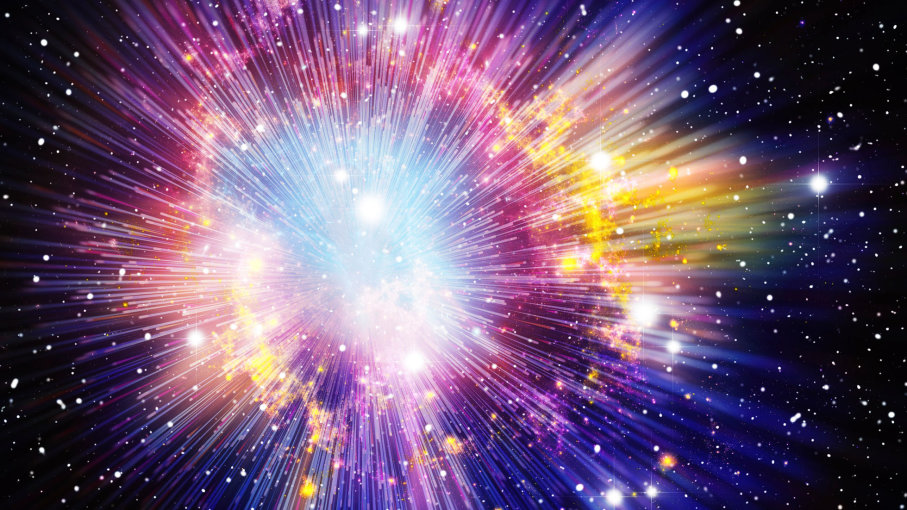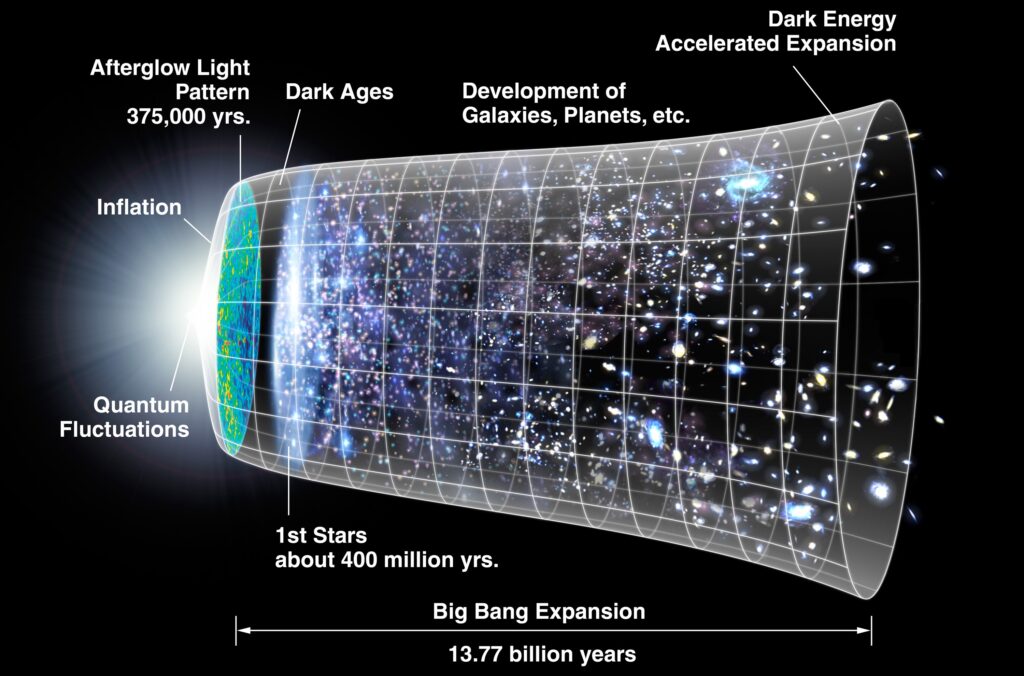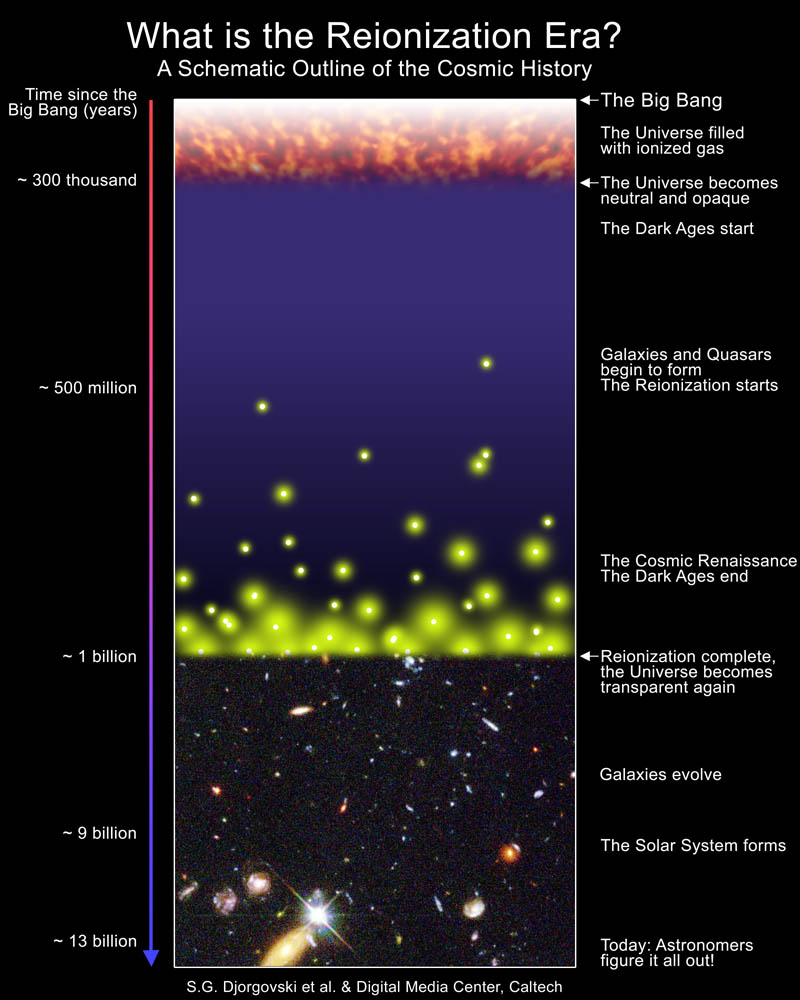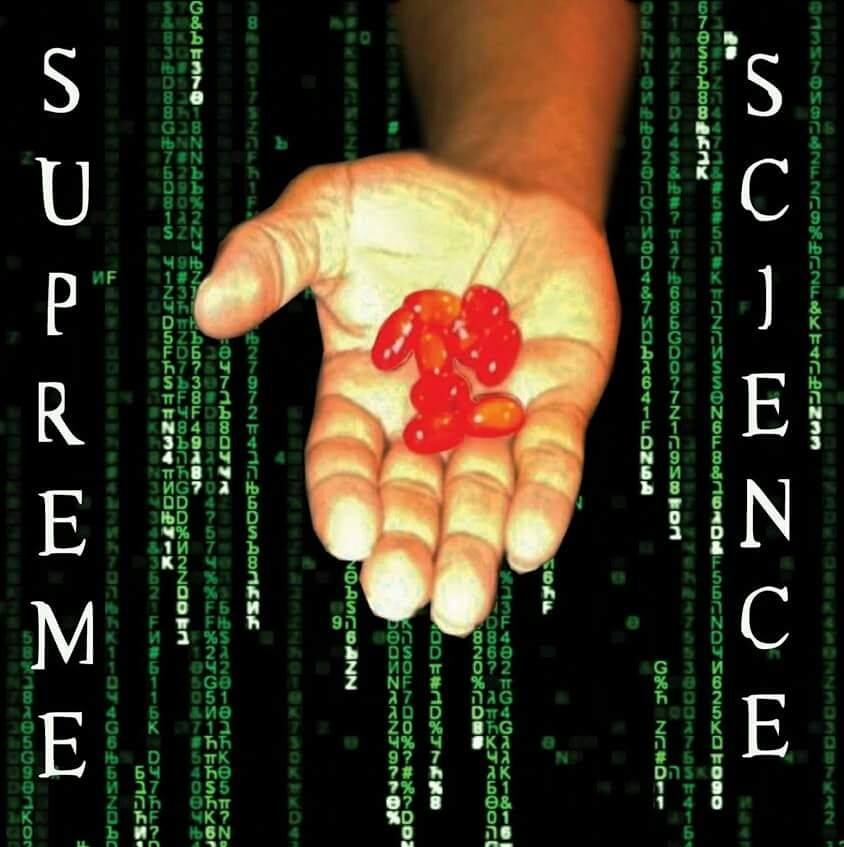
An Image Depicting What The Big Bang Looked Like!
Scientists have estimated that the new universe took 380k years to cool off enough for electrons to move slow enough to create hydrogen, helium, and lithium atoms. What’s even more interesting is the Sun is composed of 554 million tons of hydrogen being rapidly converted to 550 tons of helium per second. This conversion creates electric storms or what we call Soul-ar InnerG.The Sun/Son is a source of electricity that holds this galaxy in its magnetic pull. Jesus is named EmmanuEL for electricity and his wife Mary MAGdelene is magnetism. This becomes even more interesting when we see that 5 + 5 + 4 + 5 + 5 + 0 = 24. The planet is 24896 miles in circumference and the Solar equinox in some ancient cultures was charted by 4 6000 year cycles or 24k years. To couple, this with the estimate of the universe taking 380k years to create atoms we see 3 + 8 + 0 = 11 and the 11th attribute of Allah is Al Khalaqa the creator. The 11th Hebrew alphabet is Kaf and the 11th letter in the English alphabet is K. The 11th letter in Greek is Lambda and the Lambda sequence is what Plato said God used to create the Cosmic soul!
Life Could Have Evolved Just 15 Million Years After The Big Bang, Says Cosmologist
In the hot afterglow of the Big Bang, warm watery conditions could have existed on almost any rocky planet in the Universe, according to new calculations
One of the key questions for astrobiologists is where in the universe life might have taken hold. Their standard approach is to look for places that are warm enough to keep water in liquid form and so allow chemistry similar to our own.
That’s given rise to the idea of circumstellar habitable zones—regions around stars that are not too hot and not too cold but just right for liquid water. Goldilocks zones as they are sometimes called.
But in recent years, planetary geologists have pointed out that various other mechanisms might keep planets and moons warm enough for liquid water. For example, tidal heating can generate considerable heat. This is the squeezing and squashing of a body as it moves through a powerful gravitational field and the process that maintains a salty ocean beneath the ice on Jupiter’s moon Europa. Radioactive decay also generates heat and keeps the interior of our planet warm.
Now Abraham Loeb at Harvard University in Cambridge says there is another mechanism that creates a Goldilocks zone but in this case the zone is in time rather than in space. He says this mechanism would have created a Goldilocks zone that filled the entire universe for a few million years soon after the Big Bang. If he’s right, that means life could have evolved some 10 billion years before it cropped up on Earth.
The key phenomenon in Loeb’s reasoning is the cosmic microwave background radiation, the afterglow of the Big Bang which fills the universe with light.
This radiation was once blazing hot. But as the universe has expanded, the wavelength of this light has increased and become less energetic. Today, it is freezing with a temperature of around 3 Kelvin.
Loeb points out that as it cooled, at some point this radiation must have once been amenable to life. Indeed, it would have been warm enough to maintain water in liquid form on a planet, regardless of its distance from its parent star.
And Loeb has calculated exactly when. He says the cosmic microwave background radiation would have had a temperature of between 273 and 300 Kelvin (between 0 and 30 degrees C) about 15 million years after the Big Bang and this would have lasted for several million years. That would have allowed “the chemistry of life to possibly begin when the Universe was merely 15 million years old,” he says.
That’s an exciting possibility but one that comes with a number of caveats. The first is the question of whether planets could have formed at all at this stage of the universe.
The question arises because to start with, the cosmos was filled only with hydrogen and helium. The heavier elements were forged inside stars and so came later.
So an important question is whether the cycle of heavy element formation could have advanced enough in these 15 million years to allow rocky planets to have formed along with the variety of elements necessary for the chemistry of life.
Loeb is optimistic on this point. He calculates that the first stars, which would have been tens to hundreds of times more massive than the Sun, had a lifespan of about 3 million years. And although they would not have formed immediately after the Big Bang, he calculates there ought to have been time enough for heavy element formation in 15 million years.
So the conditions were certainly possible that would have “triggered the formation of rocky planets with liquid water on their surface,” he says.
A much bigger question is whether life could have evolved in these conditions and in this timescale. That’s something that Loeb is unable to help with.
Nevertheless, this a fascinating idea. If life did evolve during the Universe’s Goldilocks epoch, it would have predated life on Earth by 10 billion years.

An Image Showing The Universe’s Evolution From Dark Energy
THE FOLLOWING IS A TIMELINE OF HISTORY COUNTING BACK TO THE BIG BANG!
60 years ago – Invention of the computer.
130 years ago – Invention of the telephone.
180 years ago – Fossil fuel revolution: coal, trains.
540 years ago – Invention of the printing press.
5,500 years ago – Invention of the wheel, writing.
7,600 years ago – Sahara desert starts forming in northern Africa.
8,800 years ago – The first cities.
10,300 years ago – End of the most recent glacial period: the Wisconsin glaciation.
12,700 – 11,500 years ago – the Younger Dryas.
18,000 years ago – Cultivation of plants, herding of animals. Homo sapiens arrives in the Americas.
21,000 years ago – Last glacial maximum: ice sheets down to the Great Lakes, the mouth of the Rhine, and covering the British Isles.
32,000 years ago – Oldest known cave paintings.
35,000 years ago – Invention of the calendar, extinction of Homo neanderthalensis. Homo sapiens arrives in Europe.
50,000 years ago – Homo sapiens arrives in central Asia.
100,000 years ago – Homo sapiens arrives in the Middle East.
110,000 years ago – Beginning of the most recent glacial period: the Wisconsin glaciation.
130,000 years ago – Beginning of the Eemian interglacial.
200,000 years ago – Beginning of the 2nd most recent glacial period: the Wolstonian glaciation.
250,000 years ago – First Homo sapiens.
350,000 years ago – First Homo neanderthalensis.
380,000 years ago – Beginning of the Hoxnian interglacial.
450,000 years ago – Beginning of the 3rd most recent glacial period: the Kansan glaciation, during which ice sheets reached their maximum extent in the Pleistocene, down to Kansas and Slovakia.
620,000 years ago – Beginning of the Cromerian interglacial.
1.4 million years ago – First firemaking by humans.
1.9 million years ago – First Homo erectus.
2.5 million years ago – First Homo habilis. Beginning of a period of repeated glaciation (loosely speaking, “ice ages”).
3 million years – Cooling trend causes year-round ice to form at the North Pole.
3.9 million years ago – First known Australopithecus afarensis.
5 million years ago – Humans split off from other apes (gorillas and chimpanzees).
21 million years ago – Apes split off from other monkeys.
24 million years ago – Cooling trend causes the formation of grasslands; Antarctica becomes covered with ice.
34 million years ago – Gondwanaland finishes breaking up, with Australia and South America separating from Antarctica.
50 million years ago – India begins to collide with Asia, eventually forming the Himalayas.
67 million years ago – Asteroid hits Mexico, causing the Cretaceous-Tertiary extinction. End of dinosaurs. 50% of all species died out! Intensification of world cooling trend.
114 million years ago – First modern mammals. World begins to cool.
150 million years ago – First birds.
200 million years ago – Pangaea began to split into separate continents: Gondwana to the south and Laurasia to the north, separated by the Tethys Sea.

205 million years ago – The Triassic-Jurassic extinction. End of large amphibians and many reptiles.
235 million years ago – First dinosaurs, flowers.
250 million years ago – The Permian-Triassic extinction. 90% of all species died out! Formation of the supercontinent Pangaea, with surrounding ocean Panthalassa.

313 million years ago – First reptiles.
365 million years ago – The Late Devonian extinction. 70% of marine species died out! First amphibians, trees.
395 million years ago – First insects on land.
415 million years ago – The Old Red Sandstone Continent, also known as Laurussia, is formed by the collision of Baltica and Laurentia at the beginning of the Devonian.
440 million years ago – The Ordovician-Silurian extinction. Most marine species died out.
670 million years ago – First animals.
630-850 million years ago – The Cryogenian Period, also known as Snowball Earth – the worst ice age in the Earth’s history.
800 million years ago – The supercontinent Rodinia begins to break up.
1 billion years ago – Formation of the supercontinent Rodinia
1.3 billion years ago – First plants.
1.6 billion years ago – First blue-green algae.
2.4 billion years ago – The Great Oxidation Event: the Earth’s atmosphere gets oxygen.
3 billion years ago – Formation of the first known continent, Ur.
3.8 – 4 billion years ago – The Late Heavy Bombardment: a period during which the Earth, Moon, Venus and Mars were subjected to many asteroid impacts, after a relatively calm period of several million years.
4 billion years ago – First life on Earth.
4.45 billion years ago – Formation of Earth complete; storm of asteroid impacts.
4.5 billion years ago – Formation of the Moon: according to the Giant Impact Hypothesis, this happened when Theia collided with proto-Earth.
4.55 billion years ago – Formation of the Solar System.
13.3 billion years ago – Reionization: the first stars heat and ionize hydrogen gas.

An Image Depicting The Re-ionization Era
13.3 – 13.7 billion years ago – The Dark Ages, after the formation of hydrogen and before the first stars.
13.7 billion years ago – The Big Bang: beginning of the universe as we know it!

In what follows I give the temperature of outer space in Kelvin at various times. Kelvin means “degrees Celsius above absolute zero”. The melting point of water is 273 Kelvin; the boiling point is 373 Kelvin.
13.7 billion years after the Big Bang – Now.
Temperature: 2.726 Kelvin
550 million years after the Big Bang – Reionization: first stars heat and ionize hydrogen gas.
Temperature: roughly 30 Kelvin.
380 thousand years after the Big Bang – Recombination: hydrogen gas cools down to form molecules.
Temperature: 3000 Kelvin.
10 thousand years after the Big Bang – End of the radiation-dominated era.
Temperature: 12,000 Kelvin.
1000 seconds after the Big Bang – Decay of lone neutrons.
Temperature: roughly 500 million Kelvin.
180 seconds after the Big Bang – Beginning of nucleosynthesis: formation of helium and other elements from hydrogen
Temperature: roughly 1 billion Kelvin.
10 seconds after the Big Bang – Annihilation of electron-positron pairs.
Temperature: roughly 5 billion Kelvin.
1 second after the Big Bang – Decoupling of neutrinos.
Temperature: roughly 10 billion Kelvin
100 microseconds after the Big Bang – Annihilation of pions.
Temperature: roughly 1 trillion Kelvin
50 microseconds after the Big Bang – “QCD phase transition”: quarks get bound into neutrons and protons.
Temperature: 1.7-2.1 trillion Kelvin
10 picoseconds after the Big Bang – “Electroweak phase transition”: electromagnetic and weak force become different.
Temperature: 1-2 quadrillion Kelvin
FOLLOW
iNSTAGRAM REDPILLGANG99
https://www.facebook.com/dewayne.hendrix
https://www.facebook.com/groups/257379211490785/
http://math.ucr.edu/home/baez/timeline.html

TAKE THE RED PILL NEO!



















